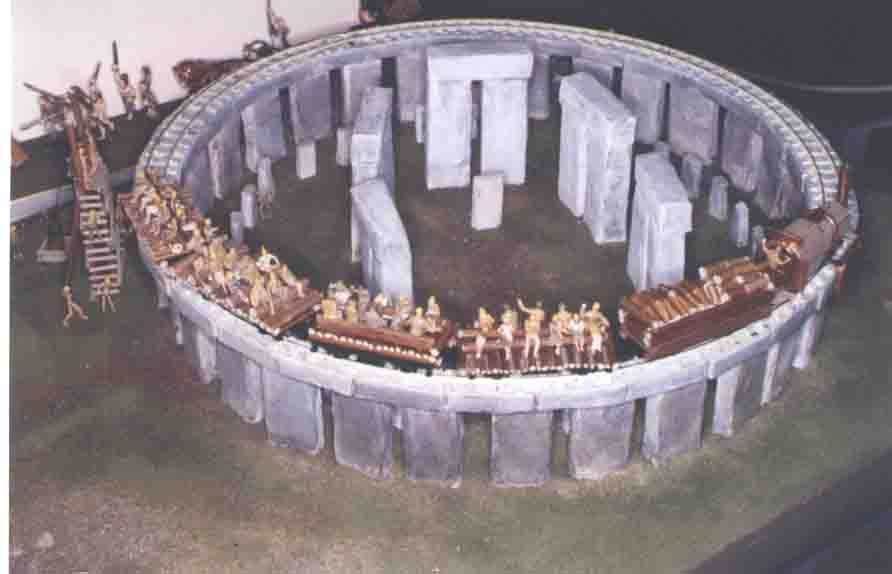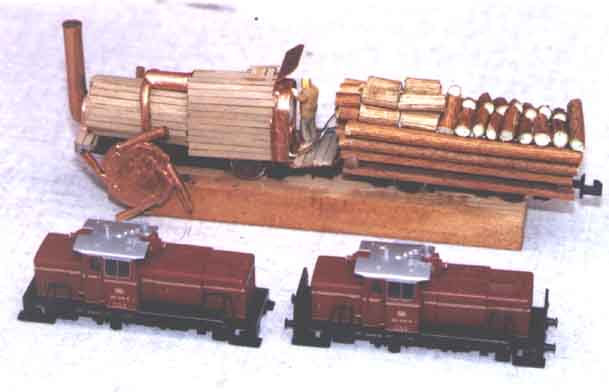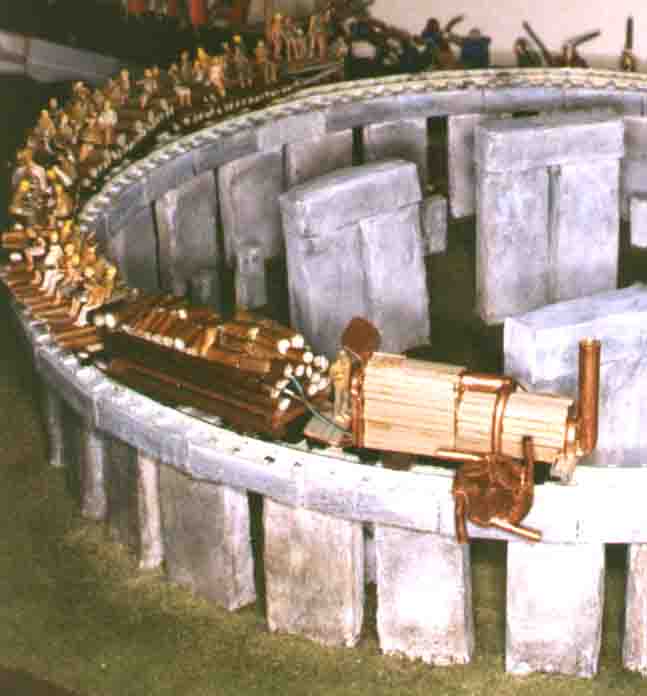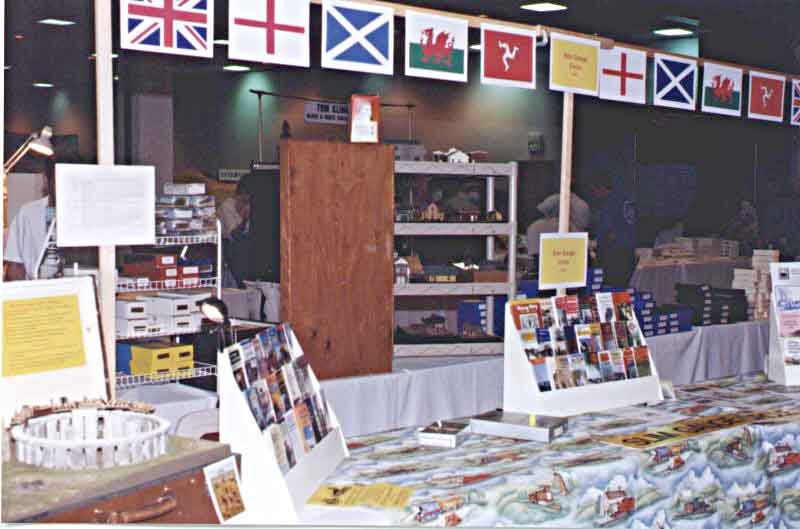The Stonehenge Railway
(c) Antique Metalware Society
Small extracts can be used with acknowledgements to 'Oldcopper.org' website.
Helpful comments are very welcome.

Stonehenge Light Railway
© Vin Callcut 2002
The steam turbine was invented about 150BC by Hero, a Greek physicist in Alexandria, Egypt.
It was a stationary engine driven by jets on the rim of a sphere.
He wanted to put it to good use as a locomotive engine.
He was advised by Phoenician traders to go to the British for their expertise in copper working.
The steam was used as peripheral jets to drive the wheels.
For practical purposes he needed an elevated railway.
Stonehenge was ideal for the purpose.
Unfortunately
The Stonehenge lintels were only 3’ 6" wide, necessitating a narrow gauge.
The Romans had standardised on 4’ 8½" gauge for chariots and carts.
When they invaded Britain they ruled the Stonehenge railway non-standard and therefore destroyed it and all records.
Now Read On!!
The Stonehenge Light Railway (in a suitcase!) was a great success at the Narrow Gauge Convention in Portland, Oregon. As it happens, there’s also a replica of Stonehenge just outside Portland. It was the highlight of our Stand promoting British Steam Preservation railways and was eventually auctioned to a train shop in Austin, Texas. A write-up in '009 News' included the cover and three pages of editorial.
Origin of Steam locomotion and the Narrow Gauge
Historical
For political reasons that follow, the Romans destroyed the Stonehenge Light Railway and all written records. Although this was the world’s first steam operated railway, it has not been described in any of the major reference books. It therefore took us quite a lot of research to gather enough information to model it in time for our trip to the Narrow Gauge Convention in the USA.
The background information is clear. It is well known that Hero invented the steam turbine in Alexandria during the first century AD. He wrote about it and the reference book illustrations show that he started with by building a rectangular boiler over a firebox. Two hollow columns conducted the steam up to the pivots of a spherical steam reservoir that rotated as the steam was expelled from peripherally mounted jets. This much is well known and table top models were made in later centuries for the wonder of admiring guests.
Not generally known is the fact that he was friendly with the visiting Phoenician traders, being hungry for news of the rest of the world. He was also keen to develop his invention further and was glad to hear the recommendation to travel to Britain, home of the best coppersmiths of the day and also possessing ample supplies of charcoal, copper, bronze, wrought iron, water and enterprise. His ambition was to make his invention do useful work, perhaps to make it mobile.
He was introduced to the leading British expert, Ethelred the Grice, who pointed out that a round boiler would be more practical than a rectangular one and offered to help technical developments further, and count the rivets. The first mobile prototype worked just well enough, with steam jets driving it forwards from the periphery of large wheels running on the ground. There was however a big disadvantage that the steam scalded not only the driver and fireman but all the locals as they watched.
In order to keep the steam out of harm’s way, an elevated track was needed. The turbine jets could also be placed outboard of the wheels on a larger radius to give more effective traction on the wheels.
The obvious structure to use for an elevated trackbed was the circle of lintels set up on tall stones at Stonehenge. This had been at the centre of civilisation up to a thousand years previously but now lay derelict and ignored. It now provided an ideal support structure. This landmark on Salisbury Plain in Southern England may now never be fully understood. However, its main feature is the well known series of upright sarsen stones surmounted by the lintels in what at that time was then still a full circle. Other features included larger trilithons in the centre and rings of other stones and pits of various radii. The lintels were well installed, having been bored with sockets to fit on pegs on top of the uprights and tongued and grooved in to adjacent lintels in a way ideal to take the track stresses. Wooden rails were made and laid to keep the ‘locomotive’ from falling off. The fault planes in the stones had given them an ideal width of 3ft 6in, leading to a narrow gauge for the track and a height of 16ft above ground level.
The circular track was 100ft diameter and the locomotive was able to pull truckloads of delighted passengers round and round, giving them the chance of a good new experience near the centre of their home town in Wessex. For several years it was a local success but eventually boredom set in and interest waned when it proved difficult to enlarge the circle of trackwork.
News came that Roman legions were advancing across from mainland Europe. Revitalisation became urgent when it was realised that the railway could prove a valuable aid to defence. It was possible to mount stone-throwing balusters on flat trucks and aim them out at troops approaching from any angle. Drop-bottom gondolas were also invented at this time to shower rocks on troops trying to climb the walls of the fortifications. The interior trilithons were also well fortified.
Despite these defences, the Roman attack unfortunately prevailed. Across the rest of Europe, the Romans had already standardised 4ft 8½in for chariot wheel gauge. The narrow gauge of Stonehenge was abhorrently non-standard to them. After their victory, they methodically destroyed the railway with the intention of leaving no trace of the superiority of the local British engineers.
The expertise of the Icene, Celtic, Pictish and other tribes was dispersed with most retreating Northwards and Westwards. However, some traces can still be found. Some returned to North Wales to defend the two big copper mines at the Great Orme and Parys Mountain but then inspired the narrow gauge railways of the slate mines and the Isle of Man. Others went across the sea to Ireland to continue developing the monorail design at the Listowell and Ballybunion Railway. More ended up crossing the Atlantic and settling in Colorado to meet the bigger challenges of building three foot gauge railroads to get valuable metals down from the mountains.
A Brief History of Stonehenge
Phase |
Date |
Developments |
1 |
pre-2,900BC |
Site occupied since Mesolithic times. Circular ditch prepared together with holes inside for timber posts. Main entrance aligned with midsummer sunrise. |
2 |
2,900-2,400BC |
Many more timbers erected in complicated patterns now largely obscured. Post holes now being infilled with cremation burials. |
3i |
c2,400BC |
Bluestones brought in from Preseli Mountains of South Wales and set in part circular plan. Stone sizes up to 9ft x 4ft x 2½ ft each. |
3ii |
c2,300BC |
Sarsen stones brought from Marlborough Downs and set to form continuous circle 100 ft dia. with lintels set on spigots and with interlocking tongue and grooved joints to form horizontal top. Axis realigned with greater accuracy. Horseshoe of five sets of trilithons built inside main circle, these stones being up to 28ft tall and weighing up to 40 tons each. Altar Stone, Heel Stone, Slaughter Stone and four Station Stones probably positioned with astronomic precision at this time. |
3iii |
c2,200BC |
Bluestones augmented and re-arranged to form short-lived inner circle. |
3iv |
c2,000BC |
Dressed bluestones set in an oval within the Trilithon horseshoe. Circle of undressed bluestones set within main sarsen circle. |
3v |
c1900BC |
Bluestones rearranged to form inner horseshoe. |
3vi |
c1500BC |
Two concentric rings of holes dug outside sarsen circle for re-positioning of bluestones. Work never completed and further use of Stonehenge in abeyance and neglected. |
4i |
c140BC |
Hero and Grice convert sarsen ring for turbine locomotive use. World's first railway proved very popular. Main diorama shows the main stone circle and trilithons together with one of the Station Stones. The locomotive is from Epoch I and has a full consist of tourist cars. |
4ii |
60AD |
Stonehenge unsuccessfully defended by Queen Boudicca and the British tribes against attack by Romans, see rear diorama. Railway and stock consigned to oblivion. 3ft gauge trackwork taken to Colorado by miners. Elevated railway developed further as monorail in Ireland at Listowel and Ballybunion. |
4iii |
1666AD on |
Site investigated by Aubrey and many others subsequently. Some stones removed for various purposes. Some fallen stones re-erected. No trace of railway found. |
The Model
The requirement was for an eye-catching model that would fit in a suitcase and travel easily to the Narrow Gauge Convention in Portland, Oregon where the Slim Gauge Circle had taken space in the traders area to promote visits to British Preservation Societies. The Stonehenge Light Railway was an ideal prototype, since near Portland is a concrete replica built by a local millionaire.
Medium density fibreboard was used for the baseboard, mounted on 1" offcuts at the edges to give rigidity. An old, strong suitcase was fitted with wooden support rails and the whole arranged rest on the rails when on display and to drop down inside for storage and transit. MDF was cut to make the uprights and supports since this can be easily be shaped and painted with emulsion to make a creditable imitation of stone. The main circular stoneworks were reproduced to scale but the available area left no room for the wider range of stones and holes. Only one of the station stones could be included.
A tasteful sprinkling of Woodland Scenics provided the ground cover over, what would have been at the time, a better layer of soil than is there today. Straight prunings of ‘Mock Orange’ from the garden provided unsawn uprights and offcuts of trestle-building wood were used to provide sway braces in building an access tower to the high track, to guard the well water supply and to support the bucket crane. Interestingly, the fresh wood proved immune to being stuck with both conventional white resin glue and the solvent glues so acc had to be used to hold the whole thing together. Hilary painted nearly a hundred modified Preiser people as Ancient Brits out to enjoy themselves and a flock of sheep appeared from somewhere.

The lid of the opened suitcase was used to display notices outlining the background to the layout and a copy of the ‘Punch’ cartoon of many years ago that was the original inspiration. At the base of the lid was a dramatic diorama showing Boudicca and her Icene charging the Romans. Since there are many more whitemetal models made of Romans than Ancient Brits, it was obvious why the Brits lost the battle. Also at the rear was mounted the spare, battery powered loco.

The Stock
Plan ‘A’ was to have the locomotive battery powered using the power truck out of a £20 N-scale HST set and avoid the need for finding a 110v power supply when we got there. Drive wheels were made of two 2p pieces soldered back to back and slotted to take copper jet pipes. These were acc’d on to 2mm dia. axles of extended length that replaced originals. Tony Nixon did a grand job of building this model using an old Rivarossi Heisler body for the loco and a modified Ffestiniog coach as the battery-containing tender. Sitting on top of the tender fuel load was a bloodthirsty-looking ancient Brit waving a very unsavoury battle trophy. In use the simple battery power was rather uncontrollable so plan ‘B’ was to use conventional chassis.
For the second loco both the engine and tender were motorised and electrically coupled for full reliability at slow speed throughout the four days of the Convention. Two Minitrix 0-8-0D chassis were modified to long wheelbase 0-4-0s driven only by the chassis gearing. Loco and tender were scratchbuilt from brass and copper to be a tight fit over the motors. Again the leading axle was drifted out and replaced with a longer one to take the 'jet driven' flywheels.

For the passenger cars, some Minitrix freight wagons were reduced to flatbeds so that wooden tree trunk benching could be added to seat the ancient Brits in comfort. Some of the benches were transverse, others longitudinal for those that wanted a sideways view.
Power was fed up to the track through one of the medium density fibreboard uprights. A 6-battery power pack was used to keep independence of doubtful mains power supplies. (Note - rechargable batteries are 1.2V and do not give the 1.5V that was needed.) A very late request for some space at the the 009 Society exhibition at Pewsey gave us a very welcoming agreement from the Gentlemen of Sussex and we were able to get in a successful trial exhibition before going off to the States.
The Convention Display
Everything was packed carefully in the suitcase and topped up with polystyrene packing granules for the flight. The old suitcase was then a good fit inside a bigger one with some more internal padding to ensure a safe flight. Nothing broke in transit and we were up and running within minutes of unpacking.
The unconventional model was very eye-catching and meant that no-one passed our stand without looking and perhaps stopping for a chat about British Railways and modelling in the UK. Remarks made were all favourable ranging from standard appreciation to the ultimate of ‘That is really Cool!’. The whole display was taken in the light spirit intended. There was one just one awkward challenge - to produce the loco in working steam powered form!
Over the stand we erected a framework displaying the flags of England, Scotland, Wales and the Isle of Man together with the Union Flag and the Slim Gauge Circle banner. On our 16 ft run of ‘Thomas’ paper covered tables we had on display about 50 leaflets available from preservation societies (and the 009 Society). Specially featured were the steam locomotive driving experience courses that are difficult to get in the USA because of harsh insurance requirements. A secondary purpose of the stand is to provide a meeting place for other Brits who attend the Convention. Since it was not in Colorado there were not so many this time but those who were enjoyed themselves as ever. We have come back keen to have a go at setting up a logging operation next.
The model ran well throughout the show, earning the and admiration praise of no less than Bob Brown in the ‘Gazette’. Charlie Getz also liked it and happily auctioned the layout off for us during the Saturday evening extravaganza so that we could return with an extra suitcase full of the cheap clothing that we had bought.
The only known evidence of the 'Stonehenge Light Railway' is now residing in Texas
.
This was the stand of the Slim Gauge Circle with the 'Stonehenge Railway' sitting on its travelling case to be see bottom left. Narrow Gauge Convention, Portland, Oregon, 1999.